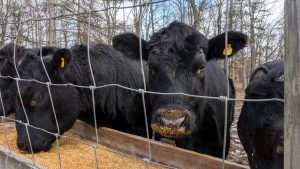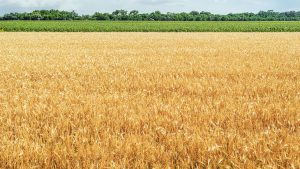Specialty grains
MARKET GROWTH DRIVEN BY CONSUMERS AND FARMERS

SPECIALTY GRAINS COMPRISE a comparatively small portion of Ontario’s annual grain crop, but growing interest in how they can be used on farm, as well as in food and beverage products, means the market for them continues to expand — albeit not without occasional hiccups.
ROTATIONAL OPTIONS
A series of challenging growing years and a general interest in diversifying cropping options has been driving more farmers to look at alternatives to the traditional corn-soybean-wheat rotation, says Quentin Martin, owner of Cribit Seeds — a grain elevator, marketing, and research company in West Montrose.
Long involved in researching oat, barley, and spring wheat lines from both Eastern and Western Canada, as well as Europe, Martin says the increasing interest in alternatives to winter wheat also has them investing in a new line of winter barley.
“It’s an alternative to wheat for winter cover, erosion prevention, and an earlier harvest,” says Martin. “I’m surprised at the number of calls we’ve been getting about it already. That’s a credit to growers. They’re looking for options.”
The new strain thus far shows higher yields (compared to varieties of more uncertain origin), though requires earlier fall planting.
“It’s an earlier harvest than winter wheat, so there’s still a possibility of double crop in some cases,” he says when referring to areas with suitable numbers of annual crop heat units. From Cribit Seeds’ position as a grain marketer, Martin adds the number of recent springs not conducive to good spring cereal growth was another motivating factor behind their winter barley investments.
“We’re in early days on this one. We are probably two years from having a registered variety available.”
DIVERSITY
Joanna Follings, cereals specialist with the Ontario Ministry of Agriculture, Food and Rural Affairs, also says farmers have been driving research into alternative winter crops. Many are looking for value-added cereals, whether with the crop itself or, as Martin mentions, for double-crop systems.
“For growers there are new oat lines coming. We’re definitely moving the bar on that,” says Follings. “Hopefully some new winter barley lines will be made available in the next couple years.”
The other — and perhaps more notable — contributor to growing markets for alternative grains has been the ever-increasing diversity of foodstuffs. This includes raw products such as quinoa and amaranth, as well as rye for commercial distillers. The adoption of spelt, purple barley, and a myriad of other grains for specialty breads and diets is another example.
Processed foods and beverages requiring dairy alternatives are another area of growing demand, though one Follings reiterates is also being met by more traditional crops.
“Oat milk for instance is something we’ve seen a lot of interest in,” she says, citing the line of “oat-milk” products recently launched by Starbucks as a large-scale commercial example.
MEETING DEMAND
According to her experiences speaking to farmers and end-users, Follings says most specialty grains stay within the province. Some products, such as malting barley, often stays within the immediate locality to supply nearby craft breweries and malting houses.
“Because specialty grains are usually grown on a smaller acreage its difficult to make it competitive for export markets,” she says. “Malt houses and brewers still get a lot from abroad. They need consistency and quantity from Ontario, but that’s not being filled at the moment.”
Nicole Mackellar, Grain Farmers of Ontario’s manager of Market Development, says pursuing opportunities in export markets does not currently make sense, specifically because domestic demands are going unfilled.
“Before we look at any export market opportunities, we want to make sure we are able to supply our domestic demand,” says Mackellar. “This demand is increasing year after year, creating new market opportunities for Ontario grain farmers.”
Supplying domestic markets requires more than just expanded acreage — infrastructure and supply-chain systems need to be developed in some cases too. Oats destined for the gluten-free market, for example, require additional systems to avoid cross contamination.
“There is a strong demand for gluten free oats within the province. While we know oats are gluten free by nature, in order for companies to be able to label their products as ‘Gluten Free’ there are very specific requirements the value-chain needs to adhere to. Currently we do not have the systems in place to be able to provide this.”
Another specialty area Grain Farmers of Ontario has been investigating is the opportunity for white corn production in Ontario. White corn is typically grown in the southern regions of the U.S. and South Africa, however, there is growing interest for a local supply. Two years ago, Grain Farmers of Ontario supported a project with a large pasta manufacturer that was interested in an Ontario supply of the commodity. The project was focused on testing several varieties of white corn from the U.S. to determine agronomically if they could be grown here with the same quality. The results were very positive with the corn harvested in Ontario meeting all of the quality specifications required by the manufacturer.
PANDEMIC INFLUENCE
COVID-19, and the changes it prompted in consumer behaviour, had varying impacts on specialty grains.
While demand for cooked-at-home quinoa continues, Martin says he was surprised at the surge in demand for dehulled barley — a common ingredient in pet food.
“Like other things, when COVID-19 came upon us, there was some hoarding. It created instant demand,” he says. “I’m not sure why this has continued, but demand has sustained beyond that initial clearing out the pipeline. I’m assuming this will all settle, but it was neat to have a spike in demand.”
Conversely, the lack of socializing opportunities between March and July dramatically reduced the brewing industry’s demand for roasted grains.
“It’s been a huge disruptor for that industry. It was probably at a stage in its maturity where there was going to be change happening. COVID-19 did something to that,” says Martin, reiterating his observations relate specifically to his and his colleagues’ own experiences.
On a provincial scale, Mackellar says the markets for barley, oats, and other more specialty grains have in many ways been less volatile than soybeans and corn — the latter of which being particularly hard-hit after plunges in ethanol demand.
Still, the pandemic-induced change has not been all bad.
“One of the positives from a grain perspective is we have seen a significant demand for grain-based products. We’re seeing it in general as more people realize the functionality and health benefits of grains,” Mackellar says. “We’re hoping that will continue.” •






















